Overview
- Description
- Collection of pre-war and wartime photos belonging to Izzica Gaon (donor's late husband), from Yugoslavia.
- Credit Line
- United States Holocaust Memorial Museum Collection, Gift of Yaffa Gaon
Physical Details
- Genre/Form
- Photographs.
- Extent
-
1 folder
Rights & Restrictions
- Conditions on Access
- There are no known restrictions on access to this material.
- Conditions on Use
- Material(s) in this collection may be protected by copyright and/or related rights. You do not require further permission from the Museum to use this material. The user is solely responsible for making a determination as to if and how the material may be used.
Administrative Notes
- Holder of Originals
-
United States Holocaust Memorial Museum
- Legal Status
- Permanent Collection
- Provenance
- Donated to the United States Holocaust Memorial Museum in 2017 by Yaffa Gaon, widow of Izzica Gaon.
- Record last modified:
- 2023-02-24 14:32:46
- This page:
- https://collections.ushmm.org/search/catalog/irn594848
Download & Licensing
- In Copyright - Use Permitted
- Terms of Use
- This record is not digitized and cannot be downloaded online.
In-Person Research
- Request 7 Days in Advance of Visit
- Plan a Research Visit
-
Request in Shapell Center Reading Room
Bowie, MD
Contact Us
Also in Gaon family collection
The collection consists of photographs, folk objects, coffee pots, a bowl, a tray, a bottle and a pair of socks that relate to the experiences of Mencham, Lottie, and Izzica Gaon and Esther Mussafia before, during and after the Holocaust.
Date: 1919-1945
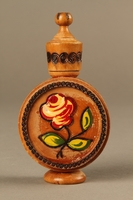
Wooden perfume bottle holder with recessed designs owned by a Yugoslavian family
Object
Wooden perfume bottle holder owned by a member of the Gaon family in Yugoslavia, during the Holocaust. The Gaon family, Menachem (Mento), his wife Lottie and their son Izzica, lived in Sarajevo, Yugoslavia when Germany and its allies invaded and occupied Yugoslavia on April 6, 1941. Central Yugoslavia, including Sarajevo, was formed into the independent state of Croatia, ruled by the Ustasa. Soon after occupation, Mento and Lottie were arrested and sentenced to 15 days hard labor. Later that year, the family escaped to the city of Split in the Italian-occupied zone where they would be safe. The Italian authorities treated Jews fairly, and rejected German demands to transfer Jews to German camps. In January 1942, the Italian authorities transferred the family from Split to Hvar Island. While there, Lottie arranged for her niece, Esther Mussafia, whose parents had been killed in concentration camps, to join them. From Hvar, they were transferred to Rab Island and interned in the Rab concentration camp. The Jewish section of Rab was equipped with food, schools, and a library. However, the Slovenian and Croatian section was kept in squalid condition and many prisoners died. In September 1943, after Italy surrendered to the Allies, the prisoners revolted and liberated themselves. Mento and Lottie then joined a partisan group and the family lived in the forests of the Velebit Mountain range, until the war’s end. In 1948, the Gaons immigrated to Israel.
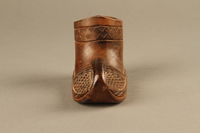
Small handmade wooden boot owned by a Yugoslavian family
Object
Small, wooden shoe owned by a member of the Gaon family in Yugoslavia during the Holocaust. The Gaon family, Menachem (Mento), his wife Lottie and their son Izzica, lived in Sarajevo, Yugoslavia when Germany and its allies invaded and occupied Yugoslavia on April 6, 1941. Central Yugoslavia, including Sarajevo, was formed into the independent state of Croatia, ruled by the Ustasa. Soon after occupation, Mento and Lottie were arrested and sentenced to fifteen days hard labor. Later that year, the family escaped to the city of Split in the Italian-occupied zone where they would be safe. The Italian authorities treated Jews fairly, and rejected German demands to transfer Jews to German camps. In January 1942, the Italian authorities transferred the family from Split to Hvar Island. While there, Lottie arranged for her niece, Esther Mussafia, whose parents had been killed in concentration camps, to join them. From Hvar, they were transferred to Rab Island and interned in the Rab concentration camp. The Jewish section of Rab was equipped with food, schools, and a library. However, the Slovenian and Croatian section was kept in squalid condition and many prisoners died. In September 1943, after Italy surrendered to the Allies, the prisoners revolted and liberated themselves. Mento and Lottie then joined a partisan group and the family lived in the forests of the Velebit Mountain range, until the war’s end. In 1948, the Gaons immigrated to Israel.
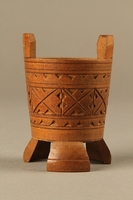
Hand carved miniature wooden bucket owned by a Yugoslavian family
Object
Small, wooden bucket owned by a member of the Gaon family in Yugoslavia during the Holocaust. The Gaon family, Menachem (Mento), his wife Lottie and their son Izzica, lived in Sarajevo, Yugoslavia when Germany and its allies invaded and occupied Yugoslavia on April 6, 1941. Central Yugoslavia, including Sarajevo, was formed into the independent state of Croatia, ruled by the Ustasa. Soon after occupation, Mento and Lottie were arrested and sentenced to fifteen days hard labor. Later that year, the family escaped to the city of Split in the Italian-occupied zone where they would be safe. The Italian authorities treated Jews fairly, and rejected German demands to transfer Jews to German camps. In January 1942, the Italian authorities transferred the family from Split to Hvar Island. While there, Lottie arranged for her niece, Esther Mussafia, whose parents had been killed in concentration camps, to join them. From Hvar, they were transferred to Rab Island and interned in the Rab concentration camp. The Jewish section of Rab was equipped with food, schools, and a library. However, the Slovenian and Croatian section was kept in squalid condition and many prisoners died. In September 1943, after Italy surrendered to the Allies, the prisoners revolted and liberated themselves. Mento and Lottie then joined a partisan group and the family lived in the forests of the Velebit Mountain range, until the war’s end. In 1948, the Gaons immigrated to Israel.
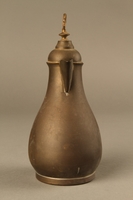
Small metal coffeepot used by a Yugoslavian family
Object
Small coffeepot owned by a member of the Gaon family in Yugoslavia during the Holocaust. The Gaon family, Menachem (Mento), his wife Lottie and their son Izzica, lived in Sarajevo, Yugoslavia when Germany and its allies invaded and occupied Yugoslavia on April 6, 1941. Central Yugoslavia, including Sarajevo, was formed into the independent state of Croatia, ruled by the Ustasa. Soon after occupation, Mento and Lottie were arrested and sentenced to fifteen days hard labor. Later that year, the family escaped to the city of Split in the Italian-occupied zone where they would be safe. The Italian authorities treated Jews fairly, and rejected German demands to transfer Jews to German camps. In January 1942, the Italian authorities transferred the family from Split to Hvar Island. While there, Lottie arranged for her niece, Esther Mussafia, whose parents had been killed in concentration camps, to join them. From Hvar, they were transferred to Rab Island and interned in the Rab concentration camp. The Jewish section of Rab was equipped with food, schools, and a library. However, the Slovenian and Croatian section was kept in squalid condition and many prisoners died. In September 1943, after Italy surrendered to the Allies, the prisoners revolted and liberated themselves. Mento and Lottie then joined a partisan group and the family lived in the forests of the Velebit Mountain range, until the war’s end. In 1948, the Gaons immigrated to Israel.
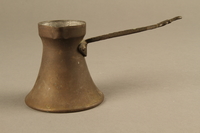
Turkish coffee finjan used by a Yugoslavian family
Object
Small finjan (also called a cevze) owned by a member of the Gaon family in Yugoslavia during the Holocaust. The Gaon family, Menachem (Mento), his wife Lottie and their son Izzica, lived in Sarajevo, Yugoslavia when Germany and its allies invaded and occupied Yugoslavia on April 6, 1941. Central Yugoslavia, including Sarajevo, was formed into the independent state of Croatia, ruled by the Ustasa. Soon after occupation, Mento and Lottie were arrested and sentenced to fifteen days hard labor. Later that year, the family escaped to the city of Split in the Italian-occupied zone where they would be safe. The Italian authorities treated Jews fairly, and rejected German demands to transfer Jews to German camps. In January 1942, the Italian authorities transferred the family from Split to Hvar Island. While there, Lottie arranged for her niece, Esther Mussafia, whose parents had been killed in concentration camps, to join them. From Hvar, they were transferred to Rab Island and interned in the Rab concentration camp. The Jewish section of Rab was equipped with food, schools, and a library. However, the Slovenian and Croatian section was kept in squalid condition and many prisoners died. In September 1943, after Italy surrendered to the Allies, the prisoners revolted and liberated themselves. Mento and Lottie then joined a partisan group and the family lived in the forests of the Velebit Mountain range, until the war’s end. In 1948, the Gaons immigrated to Israel.
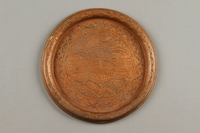
Small copper tray with a landscape scene owned by a Yugoslavian family
Object
Small tray owned by a member of the Gaon family in Yugoslavia during the Holocaust. The Gaon family, Menachem (Mento), his wife Lottie and their son Izzica, lived in Sarajevo, Yugoslavia when Germany and its allies invaded and occupied Yugoslavia on April 6, 1941. Central Yugoslavia, including Sarajevo, was formed into the independent state of Croatia, ruled by the Ustasa. Soon after occupation, Mento and Lottie were arrested and sentenced to fifteen days hard labor. Later that year, the family escaped to the city of Split in the Italian-occupied zone where they would be safe. The Italian authorities treated Jews fairly, and rejected German demands to transfer Jews to German camps. In January 1942, the Italian authorities transferred the family from Split to Hvar Island. While there, Lottie arranged for her niece, Esther Mussafia, whose parents had been killed in concentration camps, to join them. From Hvar, they were transferred to Rab Island and interned in the Rab concentration camp. The Jewish section of Rab was equipped with food, schools, and a library. However, the Slovenian and Croatian section was kept in squalid condition and many prisoners died. In September 1943, after Italy surrendered to the Allies, the prisoners revolted and liberated themselves. Mento and Lottie then joined a partisan group and the family lived in the forests of the Velebit Mountain range, until the war’s end. In 1948, the Gaons immigrated to Israel.
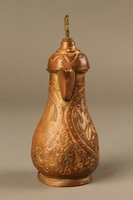
Small coffeepot and bowl with embossed designs used by a Yugoslavian family
Object
Coffeepot and bowl owned by a member of the Gaon family in Yugoslavia during the Holocaust. The Gaon family, Menachem (Mento), his wife Lottie and their son Izzica, lived in Sarajevo, Yugoslavia when Germany and its allies invaded and occupied Yugoslavia on April 6, 1941. Central Yugoslavia, including Sarajevo, was formed into the independent state of Croatia, ruled by the Ustasa. Soon after occupation, Mento and Lottie were arrested and sentenced to fifteen days hard labor. Later that year, the family escaped to the city of Split in the Italian-occupied zone where they would be safe. The Italian authorities treated Jews fairly, and rejected German demands to transfer Jews to German camps. In January 1942, the Italian authorities transferred the family from Split to Hvar Island. While there, Lottie arranged for her niece, Esther Mussafia, whose parents had been killed in concentration camps, to join them. From Hvar, they were transferred to Rab Island and interned in the Rab concentration camp. The Jewish section of Rab was equipped with food, schools, and a library. However, the Slovenian and Croatian section was kept in squalid condition and many prisoners died. In September 1943, after Italy surrendered to the Allies, the prisoners revolted and liberated themselves. Mento and Lottie then joined a partisan group and the family lived in the forests of the Velebit Mountain range, until the war’s end. In 1948, the Gaons immigrated to Israel.
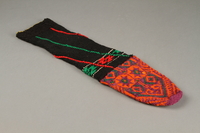
Pair of wool mid-calf socks worn by a Yugoslavian man
Object
Pair of socks owned by Menachem Gaon in Yugoslavia during the Holocaust. The Gaon family, Menachem (Mento), his wife Lottie and their son Izzica, lived in Sarajevo, Yugoslavia when Germany and its allies invaded and occupied Yugoslavia on April 6, 1941. Central Yugoslavia, including Sarajevo, was formed into the independent state of Croatia, ruled by the Ustasa. Soon after occupation, Mento and Lottie were arrested and sentenced to fifteen days hard labor. Later that year, the family escaped to the city of Split in the Italian-occupied zone where they would be safe. The Italian authorities treated Jews fairly, and rejected German demands to transfer Jews to German camps. In January 1942, the Italian authorities transferred the family from Split to Hvar Island. While there, Lottie arranged for her niece, Esther Mussafia, whose parents had been killed in concentration camps, to join them. From Hvar, they were transferred to Rab Island and interned in the Rab concentration camp. The Jewish section of Rab was equipped with food, schools, and a library. However, the Slovenian and Croatian section was kept in squalid condition and many prisoners died. In September 1943, after Italy surrendered to the Allies, the prisoners revolted and liberated themselves. Mento and Lottie then joined a partisan group and the family lived in the forests of the Velebit Mountain range, until the war’s end. In 1948, the Gaons immigrated to Israel.



